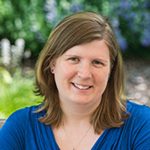“Ah, if only higher ed decision makers understood a bit more the power of digital analytics instead of ignoring it or fearing it…”
I’ve heard a version of this wish expressed by digital professionals SO many times over the years that I decided to ask your 12 higher ed colleagues on the program of the 2020 Higher Ed Analytics Conference to give me the top 3 points higher ed leaders should get about analytics.
The goal of this post compiling these suggestions is to give everybody a quick overview of the role digital analytics can play for higher ed marketing and communication.
To learn, experiment and scale up (Aaron Baker)
 I feel like higher ed leaders are more eager today than ever before to use data to inform marketing and communications decisions.
I feel like higher ed leaders are more eager today than ever before to use data to inform marketing and communications decisions.
That said, it can be a challenge to temper their expectations on what the data can tell you and what you should do about it.
My top 3 points of advice would be to:
- establish a weekly or monthly habit of collecting and reporting data,
- encourage a culture of experimentation and testing so that you’re always trying to move the needle
- start small before you scale up.
Using all three of those points, you could take one thing you already do, like producing a weekly or monthly newsletter, make data gathering and reporting a habit, try something new each time and see how it changed the stats, and then tell everyone about it.
Get the most out of your budget (Tatjana Salcedo)
 Analytics will help you identify how to get the most out of your marketing budget and web development resources by:
Analytics will help you identify how to get the most out of your marketing budget and web development resources by:
- Identifying what content is the most valuable to your audience(s).
- Measuring the value of content, UI and/or design changes.
- Determining which social media and other digital campaigns generate the most and highest quality conversions.
To optimize your budget, website and ads (Mandee Englert)

- Analytics can help you receive funding for marketing efforts including SEO, awareness campaigns and even your print advertising materials. If you are able to track the users that are interested in your institution and use analytics to tell the story of why these marketing efforts are important, it builds a case to continue to get funding for marketing efforts that could prove to be very important to your institution.
- Analytics can help you track usability and optimized web design of your websites. Rather than spending large portions of your budget on website redesigns based on what your competitors are doing or the opinions of stakeholders at the University, you can rely on analytics to tell you what your users think of your website and react to what is and isn’t working – building the best possible experience for your unique audience and the goals you are trying to meet.
- Analytics can help you determine where you should be spending your advertising budget and what channels are most effective in driving your goals. By only looking at impressions of your advertising efforts or focusing on the awareness of your brand, you are missing an opportunity to determine how your marketing efforts are affecting actions that you want your users to take including filling out an application, donating or registering to visit the campus.
To inform better strategies — and save you (Corynn Myers)

- Data and analytics inform and create better strategies. You will never know the best strategy to deploy without analytics and data. What if your lead campaign should actually be a yield campaign? What if the thing preventing you from meeting development goals is actually the experience on the donation page and not the Facebook ad? You’re wasting money and time when strategies are not backed by data. Take the guessing out of what you do. What does the data say?
- Hiring data-first marketers will completely transform how you operate for the better. Demand more from your teams and start hiring data-first marketers. Marketers with this type of mindset think differently and insert data-backed approaches to everything they do.
- Data and analytics can protect you. Waiting to utilize data and analytics until you have an application problem is too late. When done right and used correctly, data and analytics can protect you from downturns and make your strategies and processes stronger.
To assess and benchmark your work (Laura Montgomery)

- Every initiative, whether paid advertising, content publishing, or design work involves an investment of some kind – time, money, human capital, etc. Digital analytics is one of the most direct, immediate, and accurate ways to measure the returned value of any investment you make — and then make informed decisions on what to discontinue and what to expand.
- Analytics are also an essential way of establishing institutional benchmarks and measuring success in the longer term, like year over year. Every university is unique so it’s often challenging to find meaningful “industry benchmarks” — so it’s important to understand what your own averages and benchmarks are in order to determine whether you’re meeting or exceeding them.
- They’re fun! Once you start collecting digital analytics there are so many fascinating ways to slice the data to reveal different kinds of insights!
To generate buy-in — and institutional joy (Dr. Nicholas Ladany)

- First, understand that shared governance is part of the process, particularly with faculty. Trust that when they are given data, they are likely to respond favorably to the task at hand.
- Second, ignore data analytics at your own, and your school’s, peril. Data analytics enhances efficiency and accuracy in the digital marketing and communications enterprise and it would not be fiscally prudent to ignore them.
- Third, positive results, which are very likely when little data analytics have occurred, are often very well received. These positive reactions, in turn, lead to a greater desire for all involved to partake in and understand the process. I’ve seen joy on the faces of higher education leaders as they venture into the realm of data analytics.
To get faculty buy-in (Elicia Dennis)

- I think that the ethics around data are too often overlooked. It’s important to be honest about our data and where we have to make assumptions. By being transparent with the data we’re using, we build trust and make it easier to implement analytics in future situations. Once we really understand both the strengths and weaknesses of our data, it’s easier to earnestly sell analytics as a great resource.
- It is also important for us to present our data in ways that are easily digested and can be understood by a broad audience. Even though most of our campus stakeholders are highly educated faculty, the analytics we present are not their main priority. By making the information we’re sharing easier to grasp as fast as possible, we speed up the process around understanding and implementing that data.
- My most successful use of google analytics is using data to research elements of our strategic goals. The data from our websites is better received and gets deeper engagement when it is shared in the context of a goal or priority. It’s not enough to just share the analytics, we have to know the priorities of those we’re working with to offer data relevant to their individual project. Stakeholders are more invested in learning about their websites when they understand how that information ties back to their needs.
To make smart-ER decisions (Avinash Tripathi)

- Primarily act as a data storyteller to help facilitate the process of using the output from the analytics for business-related decision-making. Focus on two metrics the most at a given point in time and tie with the story (ROI).
- Put yourself in the decision maker’s shoes and think if the information presented is distracting enough with an “aha” moment to be actionable.
- Enormous amounts of student data are currently being collected by both traditional and non-traditional universities in the US starting from on-boarding a student. Differentiate the strategic insights from the “noise” from the realm of the enormous data to help optimize messaging.
To optimize resource and budget to win (Joshua Dodson)

- Resources tend to be limited and there is a need to make the most of the resources that are available.
- It is impossible to know if you are getting the most out of your marketing dollars if you aren’t measuring the impact of your marketing efforts.
- Marketing isn’t just an art — it’s also a science. Many schools are realizing that and the ones that recognize and act upon it will be the ones who have the most success moving forward. That approach is what produced many of the big names we see now, like SNHU and others.
To make decisions to impact the bottom line (Kris Hardy)

- Using goal values in Google Analytics can help you better understand the ROI of paid digital campaigns. Don’t just use any number for the goal values, work with the finance office to better understand the net tuition revenue generated by a new student, then use that number to calculate the goal value based on historical yield and/or conversion rates from that enrollment form.
- Using year-over-year data in Google Analytics (if configured correctly) can be used as a real-time indicator of how enrollment is looking for upcoming cohorts.
- It’s not just about having access to analytics, it’s about investing in staff members who can help interpret the data and make it actionable.
To win the fight for attention (Emily Gustafson)
 Higher education has always been and will always be a consumer industry – whether or not we like how that sounds. Higher ed leaders should understand that, as a consumer industry:
Higher education has always been and will always be a consumer industry – whether or not we like how that sounds. Higher ed leaders should understand that, as a consumer industry:
- We’re competing for attention, enrollment, and gifts, and not just with other institutions. Every company and cause contacting our constituents eats up their limited attention span.
- If everyone except higher ed uses advanced analytics to drive their marketing and communication toward our constituents, that’s actively harming our growth and sustainability.
- The greatest way to be a viable competitor for the attention of our potential students, alumni, and donors, is by creating a data-driven culture in our everyday work.
To drive and support efficiencies (Orion Stavre)

- Define clear goals. I think this is the most important part that a senior leader can play in promoting measurement and analytics within an institution. More so than private entities, Higher Ed is a decentralized environment, where the focus and the goals of the institution are blurred from senior leader to the next. Promoting clearly defined goals, would help focus the institution and identify the appropriate metrics of success.
- Incorporate data in all positions and decisions. If the leadership themselves uses data to make the case for their decisions and require data to justify any proposals from other leaders within the organization, this will promote a data-driven culture across all levels.
- Support building data and analytics capabilities at the enterprise level. Data is more meaningful when it is integrated across the organization and it’s used by all levels of decision makers to make decisions, but unfortunately most lack technical skills to access this data. Implementing enterprise level tools that allow data to be used freely would be important to supporting a data-driven culture.
A conference focusing on higher ed analytics?
The 2020 Higher Ed Analytics Conference (#HEA20) is a must-attend event for higher ed marketing professionals and teams looking for inspiration, ideas and best practices to step up their analytics and measurement game in 2020
Read below what your higher ed colleagues who attended the past editions of the Higher Ed Analytics Conference said about their experience.
Tags: HEA20, Higher Ed News, Karine Joly